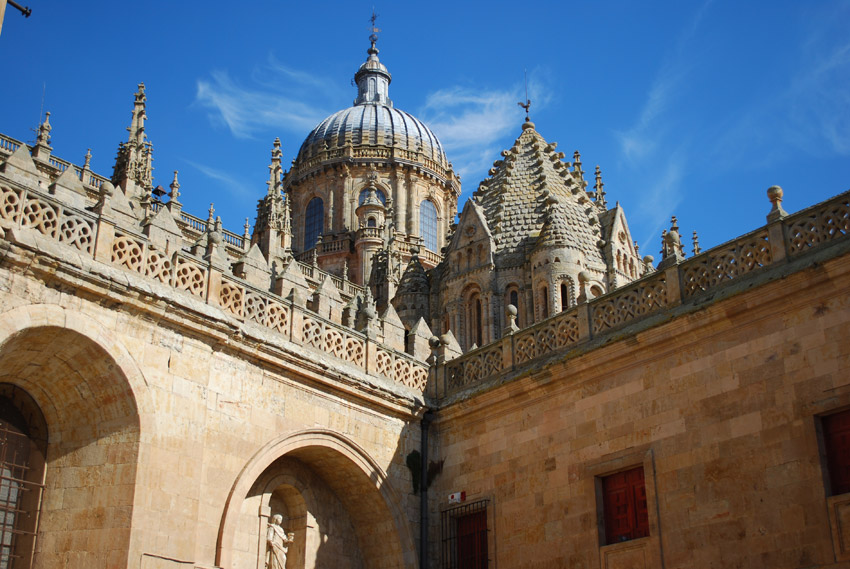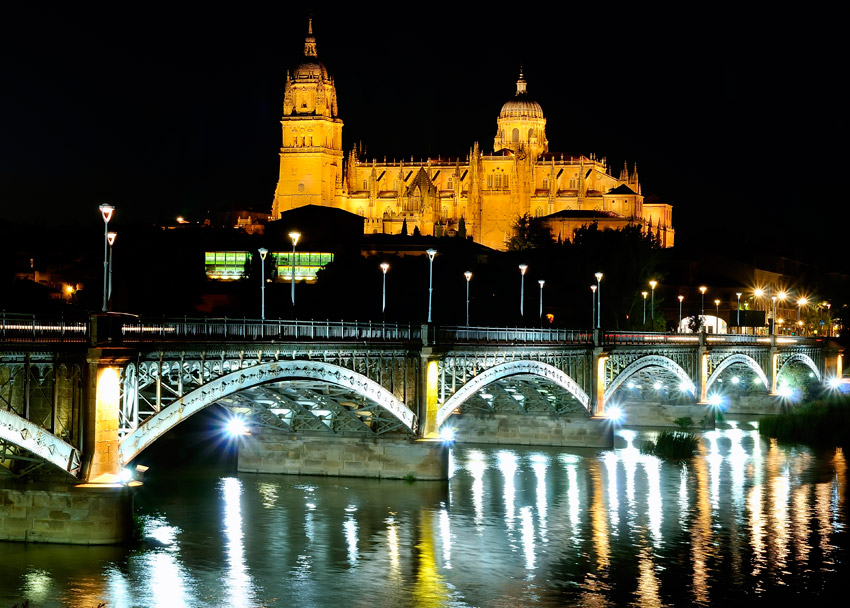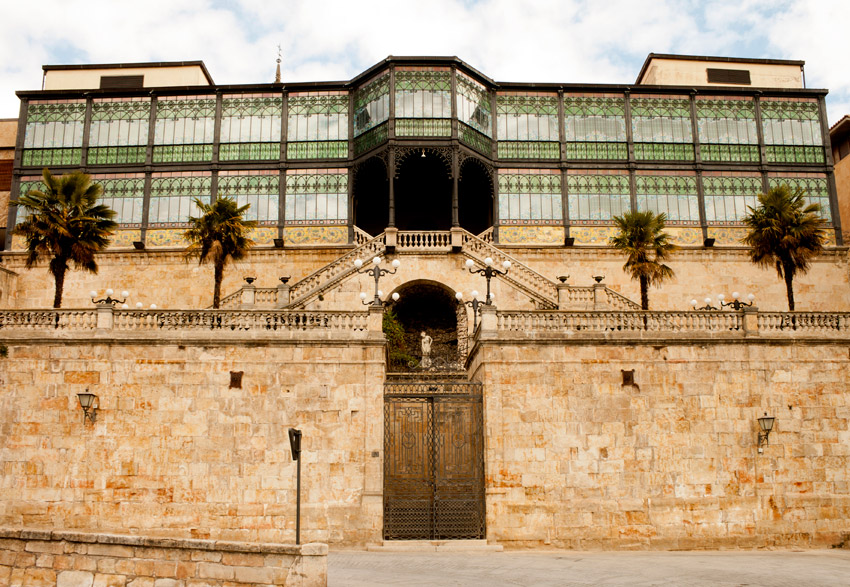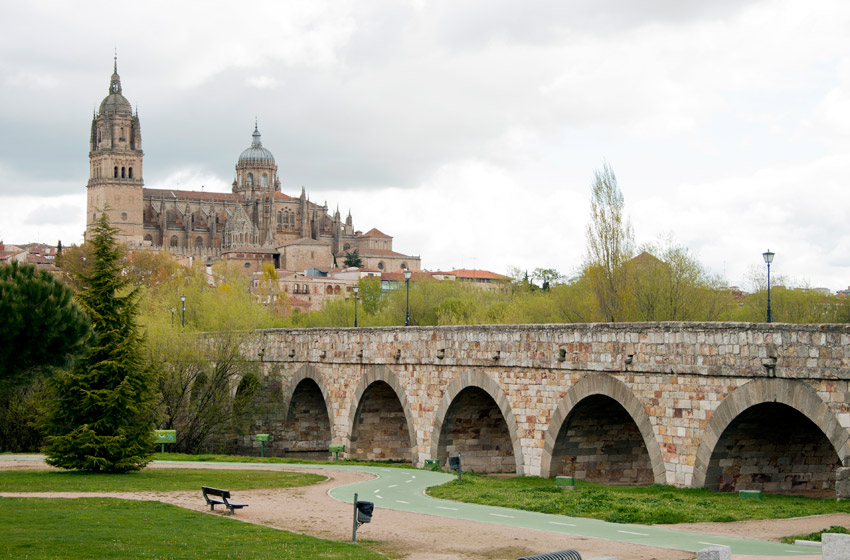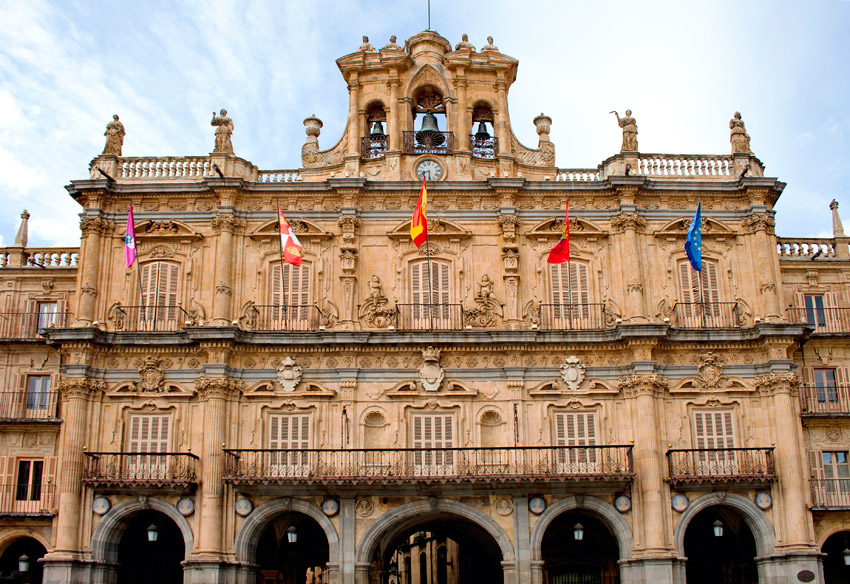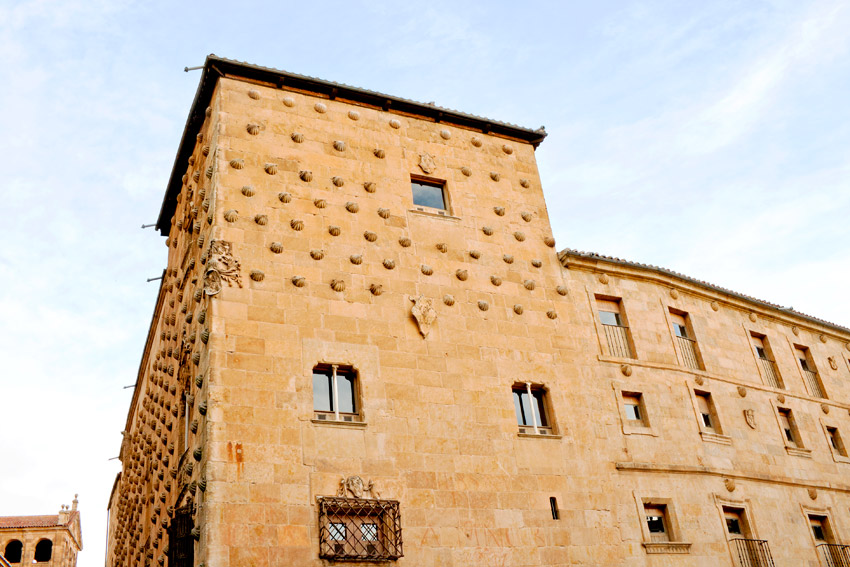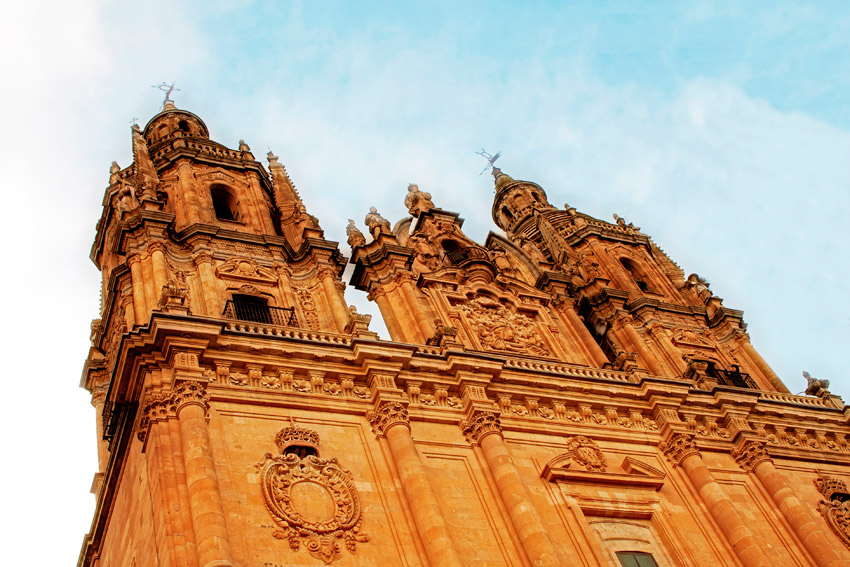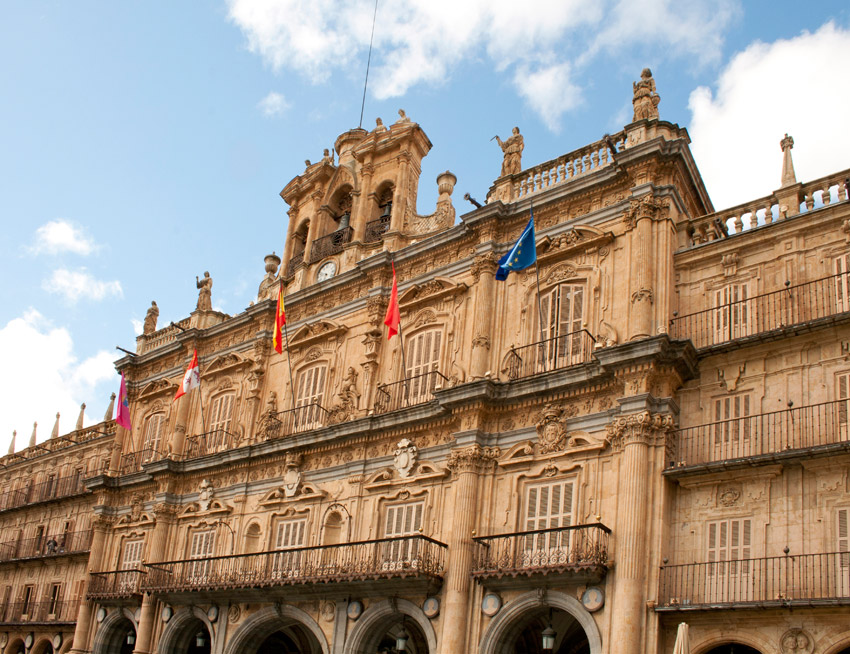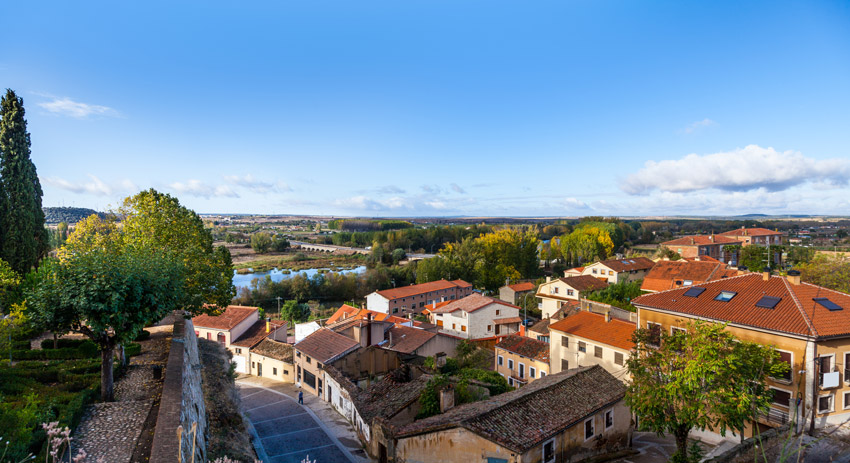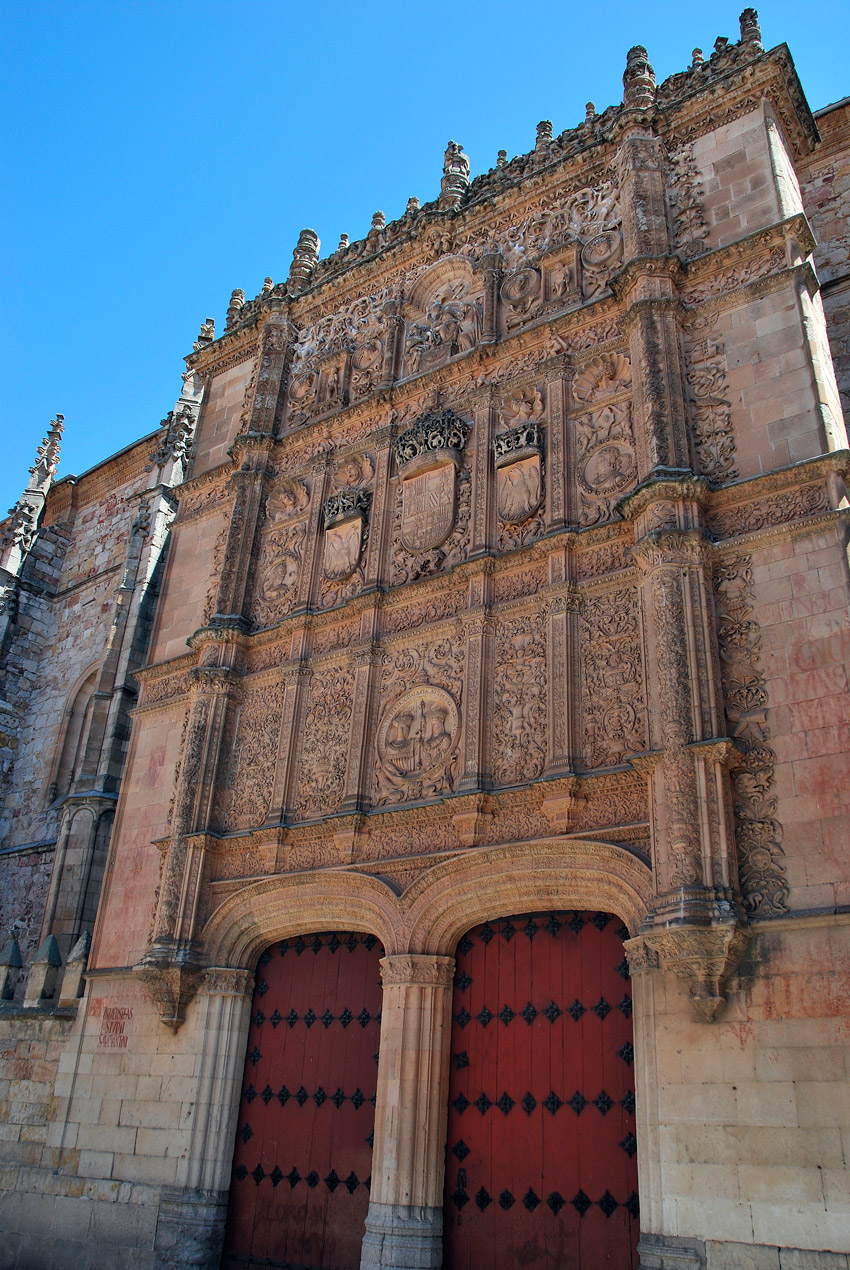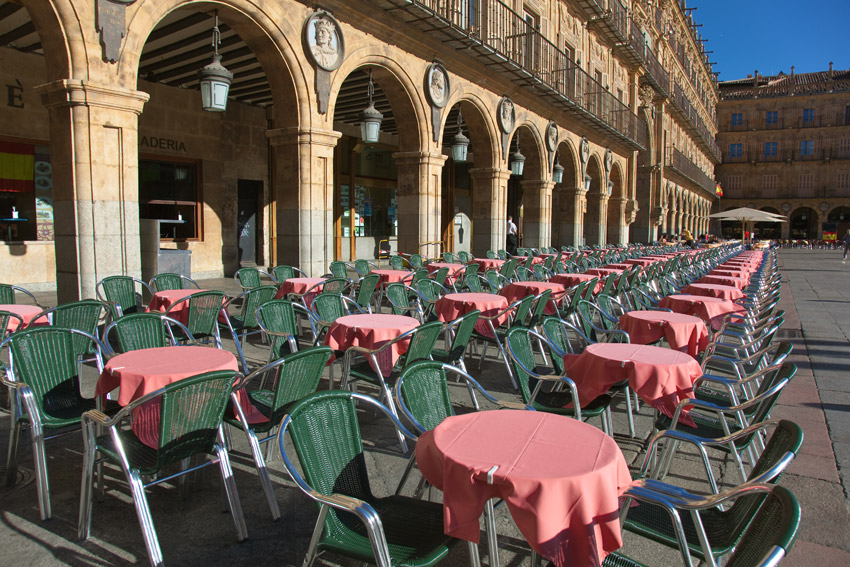Tourism
The lodge is only 15 miles from Salamanca, the most beautiful Renaissance City of Spain. The construction of its famous cathedral was started in the XIIth Century and ended in the XVth Century. The Plaza Mayor is known to be the finest in the world. The Roman Bridge, The Plateresque University Facade and some of the most impressive Churches and Monasteries in Gothic, Plateresque and Romanic styles are located in Salamanca City, known as the “Renaissance Jewel”.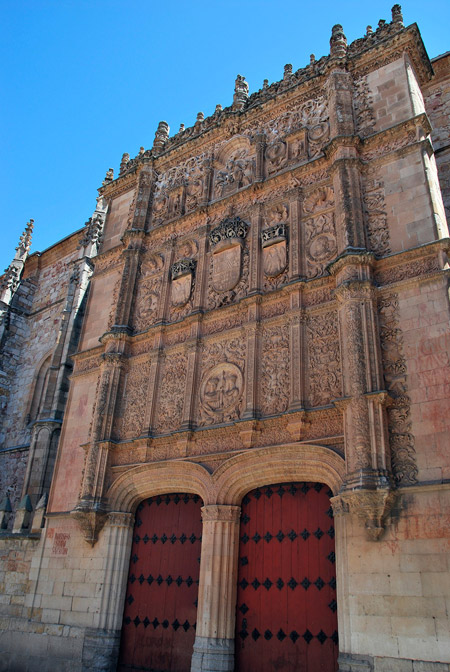
TRANSFERS
Transfers are normally done by private car from Madrid and there is a pleasant 2 hour drive to the ranch. On the way you can visit Avila and its Medieval Stone Wall, and El Escorial, the Palace of Emperador Felipe II.
A BRIEF HISTORY OF SALAMANCA
Salamanca, throughout its long history, has been a protagonist of Spain`s most significant historical events. PreRoman remains can be found in Teso de San Vicente, beside the river Tormes, in the verraco (Iberian statue representing a bull) situated in the centre of the Roman bridge, in the city walls, in numerous inscriptions and along the Calzada de la Plata which, passing through Salamanca, united Merida and Astorga. Salmántica belonged to the Roman province of Lusitania, was besieged by Hannibal and we have little information of the Visigothic era.
Conquered by the Arabs, lost and recuperated several times by the Christians, it was definitively reconquered by the great pro-European king Alfonso VI.
In 1200 Alfonso IX founded what was to become the University of Salamanca eighteen years later. Salamanca thus owes its renown and prosperity to this king. The new University soon received great favours from Fernando el Santo and Alfonso X el Sabio who established the number and type of chairs the University was to be composed of. In 12 54, Pope Alexander IV called the University of Salamanca "one of the four leading lights of the world".
Everyday life could be said to centre around the magnificent Plaza Mayor. Its archways echo with what is going on in the city.
MORE HISTORY...
The city took part in the War of Succession, on the side of Felipe V. Conquered by the Archduke`s troops, it was soon recovered by the founder of the Bourbon dynasty, who stayed here for several days in 1710, when the construction of the Plaza Mayor (Main Square) was decided on.
Salamanca was badly affected by the Peninsular War. From 1808 to 1811 it was open to the armies who disputed the hegemony of Europe on Spanish soil. At last, the battle of Arapiles, at the very gates of the city and in which Wellington defeated Napoleon`s army, led to the withdrawl of the latter from Spanish territory. But this withdrawl left behind the destruction of marvellous architectural treasures, many colleges, palaces and buildings such as the Colegio Mayor de Cuenca which was considered to be "one of the marvels of architecture".
In the field of Art, all the styles have left their most worthy and exquisite mark on this city. The Spanish Plateresque style, of decorative quality and fine execution, offers its most beautiful examples here in Salamanca. This decorative tendency of the Plateresque style finds its possibilities accentuated when carried out on a soft stone of a beautiful golden colour.
Palacio de La Salina
CELEBRITIES
Innumerable historical celebrities, from Fray Luis de Leon, Antonio de Nebrija, Francisco de Vitoria, Cervantes, Menendez Valdes, San Juan de la Cruz to Miguel de Unamuno or Gonzalo Torrente Ballester, have passed through the city, both in the university field as well as in that of the Arts, leaving the mark of their knowledge on this beautiful city.
It is the university life, in all its aspects, which adds emotion and colour to its daily rhythm. Its tradition, its atmosphere today, make it apt to be considered, like Oxford and Cambridge, the Spanish university city.
Tuna band
"Hay que buscar la vida." ("One must look for life.") — the unofficial motto of the Tuna Universitaria de Salamanca
The tuna is a consummately Spanish concept, which of course makes it virtually impossible to explain. Essentially, a tuna is a roving band of semi-professional musicians and singers, hardcore partiers, would-be womanizers (though a lot actually have steady girlfriends) and small-time con artists who dress up in costumes that date from the seventeenth century — black shirts with puffed sleeves, breeches and huge capes decorated with patches from various conferences and concerts and ribbons. Each patch supposedly represents the love of a chica.
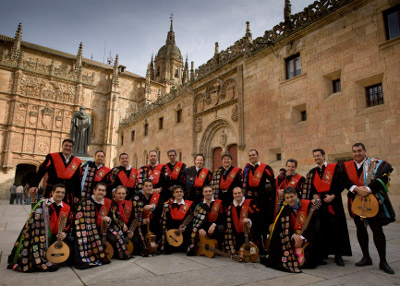 Most of their songs are about women, drinking or being from a certain region of Spain (or Portugal or Latin America, as the case may be). About half are minor-key laments; the other half are up-tempo dance numbers, and there’s a handful of songs that are both or a mixture of the two.
Most of their songs are about women, drinking or being from a certain region of Spain (or Portugal or Latin America, as the case may be). About half are minor-key laments; the other half are up-tempo dance numbers, and there’s a handful of songs that are both or a mixture of the two.
The only song I can think of that might be familiar to an American audience is "Guantanamera" (you know, "Yo soy un hombre sincero ... de donde crece la palma ... y antes de morir yo quiero ... cantar mis versos del alma ...").
Essentially, a tuna is a roving band of semi-professional musicians and singers.
They play traditional Spanish, Portuguese and Latin American music in bars, restaurants and theaters, or on street corners, or anywhere else where it seems like a good idea.
Their basic instruments are the guitar, the bandurria (a small, high-pitched guitar-like instrument that usually plays melody), the accordion and, of course, the pandereta (a small tambourine).
Gastronomy
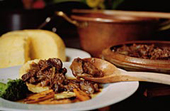 Salamanca boasts some magnificent restaurants and an excellent cuisine much appreciated by its visitors. In the city one can sample any type of pork product imaginable, which are considered an art form in the province.
Salamanca boasts some magnificent restaurants and an excellent cuisine much appreciated by its visitors. In the city one can sample any type of pork product imaginable, which are considered an art form in the province.
Well worth recommending is the “Chanfaina” (a rice dish made with the offal of poultry, lamb and sausage) and the “Hornazo” (a dry pie filled with pork products and egg), the “lomo” (cure pork sausage) and the “jamón” (cure leg of pork), the “Calderillo” (meat and vegetable stew) and the “limones” (a salad made with meat and fruit) and, to finish on a sweet note, the “bollo maimón” (a sponge cake), turrón from La Alberca (hard nougat made from almond and honey) or “almendras garrapiñadas” from Alba (sugared almonds), without forgetting the “chochos” (a typical Salmantinian sweet) which the visitor can buy in many of the city´s bakeries which, together with the restaurants, form true monuments to the culinary art.
Route 1
1. PLAZA MAYOR (MAIN SQUARE)
A marvellous example of a monumental square with portico, showing unity of style and grandeur of design, it is one of the most beautiful of Spanish squares. it was built in the 18th century, in the Baroque style, with porticoes formed by rounded arches supported on solid columns. Above them rise three-storey mansions with austere iron balconies. From between these balconies not very prominent pilasters rise up to the roof. The spaces between the arches are decorated with medallions.
The Ayuntamiento (Town Hall) is the centre of interest, as far as decoration is concerned, with typically Spanish ornamental motifs.
2. SAN MARTIN
Founded in 1103 by Martin Fernandez, its construction lasted throughout the 12th century. In it we can discern the beginning of the Salmantinian Romanic style. This church, surrounded by modern houses, encloses sepulchres of great value.

3. CASA DE LAS CONCHAS (HOUSE OF SHELLS)
This mansion could be considered the most representative civil building of the art of the era of the Catholic King and Queen. As in the culture of our 15th century, within this house can be seen to blend together Gothic, Moorish and Italian influences. its founder was Dr. Rodrigo Arias, chancellor of the Orden de Santiago (Order of Saint James), hence the use of the shell, symbol of this order, as an ornamental motif.
The windows on the ground floor are protected by exquisite bars which have been referred to as: "the most beautiful of Gothic Spanish ironwork". The patio is one of the most typical of Spanish cloisters. Of great interest is the staircase, covered by a coffered ceiling of Italian influence.
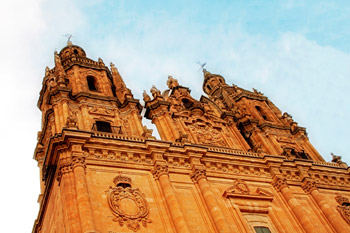
4. LA CLERECIA
This monument - one of the most beautiful and grandiose of Baroque architecture - was built thanks to Queen Margaret of Austria, wife of Felipe III. Designed by the great architect Juan Gómez Mora, the first stone was laid on 12th November, 1617.
It is not possible to fully appreciate the magnificence of the façade. The towers are some of the most beautiful in Spain of the Baroque style.
In its interior the church and its altarpieces stand out, as do the Baroque patio and diverse works of sculpture.
5. UNIVERSIDAD (UNIVERSITY)
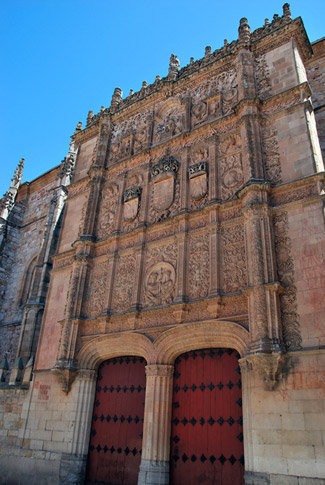
According to a royal decree, drawn up in Valladolid on 16th April, 1243 by Fernando III, Alfonso IX, King of Leon, was he founder of the Salmantinian School. This University, one of he oldest in Spain, was established only a few years after those of Bologna and Paris.
It is one of the most representative monuments of the Spanish Plateresque style, the façade being the most beautiful expression of this style.Floral themes predominate and there is a dominant Italian note in the sculptures. The moulding and the panels include masks, fruits, children, baskets, etc.
The staircase within the University, one of the artistic treasures of Spain, consists of several flights whose decorations represent the "spicy" medieval skill, the happiness of married life and scenes of games, tournaments and bull fighting on horseback. As far as dates go, we know that the decision to knock down the old staircase and start building this one was taken in 1512.
The librasy is closed off by a beautiful iron gate from the 16th century. The old library collapsed in 1664 and was rebuilt in 1749 by the great architect Manuel de Lara Churriguera, who is also the author of the rich Baroque bookcases full of rare and exquisite books from all the faculties and a Baroque cupboard where the manuscripts are kept.
6. CATEDRAL NUEVA (NEW CATHEDRAL)
Built during the 16th, 17th and 18th centuries, it is one of the last manifestations of the Gothic style. Its great height makes this cathedral one of its most famous examples.
On the outside, this cathedral presents the attractive organisation of the final Gothic period. The overall impression is one of grandeur due to its height and spiritual, ascendant feeling with luxuriant ornamentation which throw into relief the main façade and several doors: Obispo, San Clemente and, on the northern side, Ramos and Crucero.
In its interior the decoration is rich and elegant. The dome above the high altar is sumptously golden and polychromatic, the painting is the work of Juan Montejo. The choir situated in the main nave is by Alberto Churriguera. The Plateresque organ was built in 1568 by Damian Luis and the Churriguera organ dates from 1745.
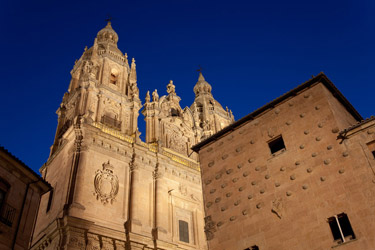 7. CATEDRAL VIEJA (OLD CATHEDRAL)
7. CATEDRAL VIEJA (OLD CATHEDRAL)
The Old Cathedral is one of the eminent monuments of Romanic art. Planned and started according to the purest canons of this style, it represents the extreme grace of the Romanic column. It dates from the 12th century. The Torre del Gallo rounds of this cathedral with its double windows and its strong ribs.
Worthy of note in the field of sculpture are the sepulchres of the 14th and 1 5th centuries and in that of paintings, the decorations of the sepulchres and of the chapel of San Marin are a very pure example of the 13th century style of French influence.
Behind the cathedral can be found one of the cosiest corners in Salamanca, the patio Chico, formed by semicircular apses.
From here can be seen the dome, called the "Torre del Gallo" (Cock Tower) because of the shape of its weather vane, derived from Byzantine and Aquitainian influences.
The sepulchres to be found here are memorable, the most sumptuous of all being that of its founder, in alabaster, situated in the centre of the chapel. This sepulchre is surrounded and isolated by beautiful iron railings, perhaps the most notable of those to be found in Spain. The organ, from the second half of the I5th century, has a ledge of Moorish design.
8. PUENTE ROMANO (ROMAN BRIDGE)
it formed part of the Roman Calzada de la Plata, which united Merida and Astorga and is supposedly from the times of the emperor Vespasiano. Only the fifteen arches closest to the city are Roman as the other eleven have undergone various reconstructions, the last being in 1677. Near the bridge can be found an Iberian "verraco" (statue of a bull), representative of pre-Roman Salmantinian art.
9. SAN ESTEBAN
The church was begun in 1524, the architect and director of the building being Juan de Alava. Its main artistic interest radicates in the facade, whose ornamental details shine and vibrate in the sun`s rays.
The portico of the convent is one of the purest examples of Renaissance architecture of the last third of the 16th century.
Tradition has it that Christopher Columbus discussed his theories about the route to the Indies with the Dominican monks. Well-known is the favourable welcome that he received and the encouragement not to give up in his venture, especially on the part of the prior, Fray Diego de Deza, which is why the discovery of the Indies is said to be due to Fray Diego de Deza and to the Dominican monks of Salamanca.
10. TORRE DEL CLAVERO
This tower is an example of the Salmantinian belligerency of the Middle Ages.
It has a square base, becoming eight-sided higher up. It was probably built by Francisco Sotomayor.
Route 2
1. PALACIO DE MONTERREY
This palace is the most popular of all the Spanish civil architecture of the Renaissance. It remains as a prototype of a noble`s house of the Spanish Renaissance, although what exists is a quarter of what it could have been as only one wing was built. It is one of the most representative works of the Spanish Plateresque style, dating from 1539 and belonging now to the Duke and Duchess of Alba.
2. COLEGIO FONSECA
Named after the Archbishop Fonseca and later after the Irish, this college unites the most select of the Plateresque architecture, It was begun to be built in 1527 and of most interest are its façade and the patio, full of grace.
The church is of the Gothic type from the period of the Catholic King and Queen and in its interior can be found an altarpiece by Alonso Berruguete.
3. CONVENTO DE LAS URSULAS
Founded in 1512 by Alfonso de Fonseca, this convent is found in one of the most beautiful and evocative spots in Salamanca. The church is Gothic in style with one nave and vaults of star-shaped and apsidal criss-cross.
Of interest is the niche decorated with medallions and columns of art by Diego Siloé. This church has 2 choirs: the main one is surrounded by a rich Gothic railing while the secondary one contains two sets of panelling with several paintings from the 16th century.
4. SAN MARCOS
This is an interesting example of a circular Romanic Church, founded in 1178. It seems to be one of the defensive round turrets of the gateway to Zamora.
It contains an attractive statue of the Virgin from the 16th century.
OTHER MONUMENTS
5. SANCTI-SPIRITUS
A typical construction of a 16th century Spanish church, its structure is Gothic although its decoration is of Italian influence.
Of interest is the lyrical altarpiece, the statue of San Rafael and the choir.
6. SAN JULIAN
Founded in 1107, in the Romanic era, it conserves its towers and the northern doorway.
The interior of the nave is of the Baroque style, except the ceiling of the chancel.

7. CASA LIS
An old private mansion in the modernist style, today restored and belonging to the Town Hall.
It` s now a Museum of art nouveau and art decó.


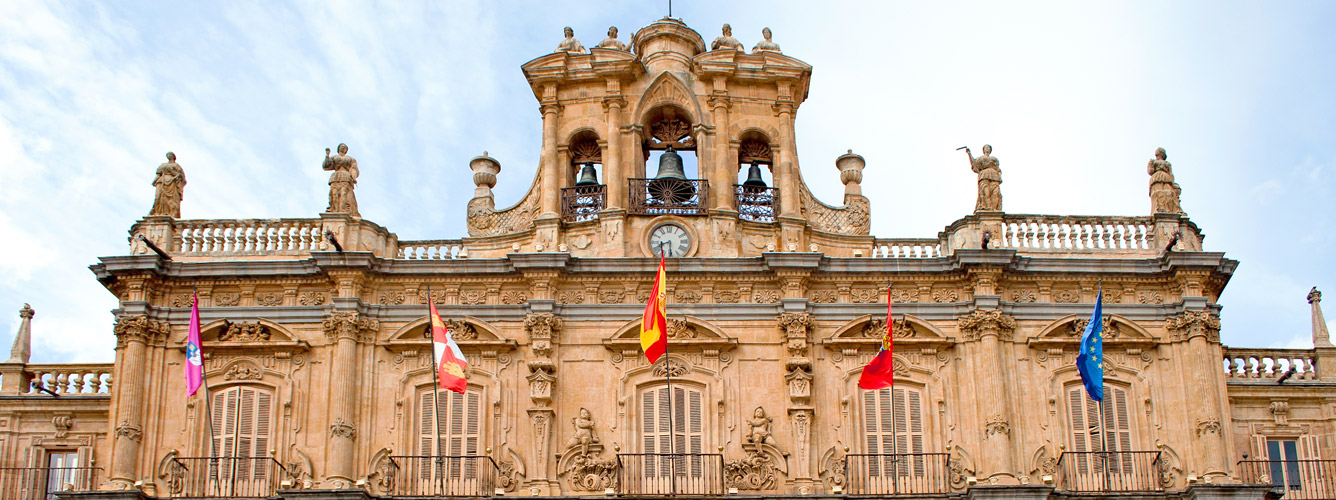
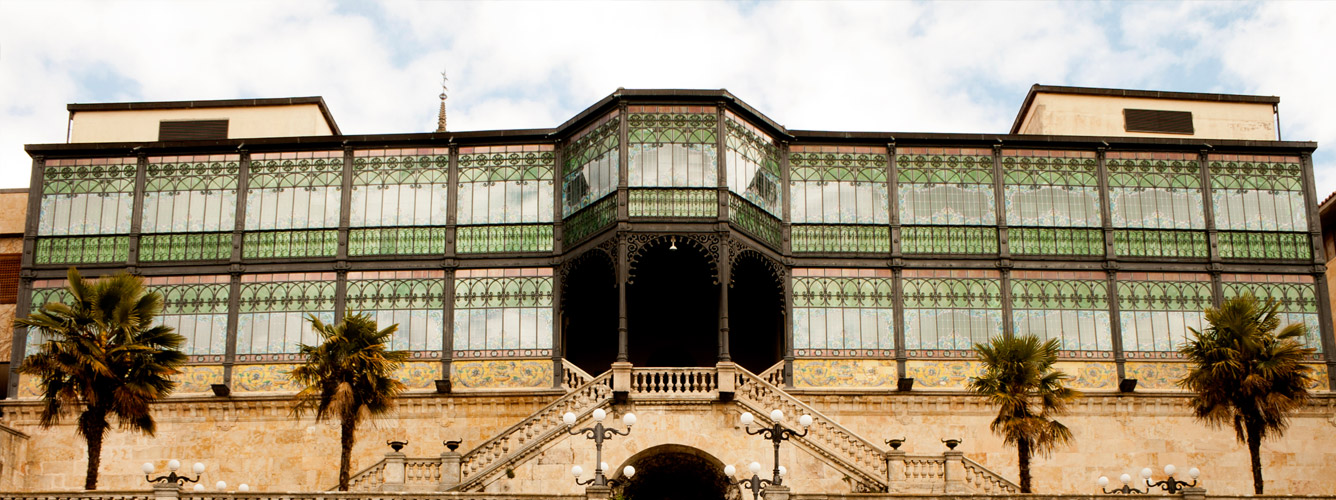
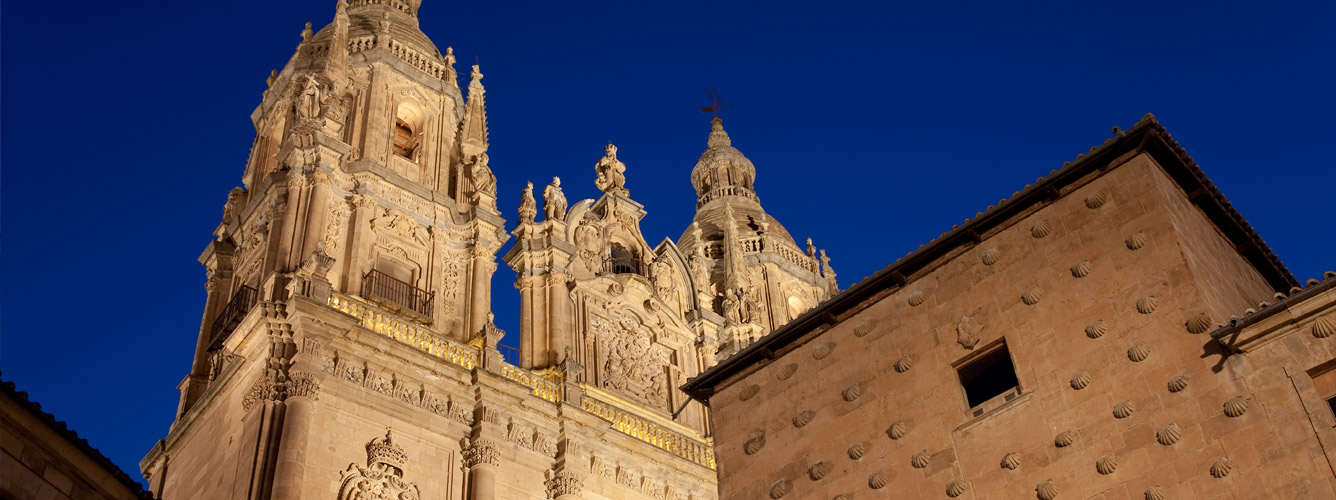

 Most of their songs are about women, drinking or being from a certain region of Spain (or Portugal or Latin America, as the case may be). About half are minor-key laments; the other half are up-tempo dance numbers, and there’s a handful of songs that are both or a mixture of the two.
Most of their songs are about women, drinking or being from a certain region of Spain (or Portugal or Latin America, as the case may be). About half are minor-key laments; the other half are up-tempo dance numbers, and there’s a handful of songs that are both or a mixture of the two. Salamanca boasts some magnificent restaurants and an excellent cuisine much appreciated by its visitors. In the city one can sample any type of pork product imaginable, which are considered an art form in the province.
Salamanca boasts some magnificent restaurants and an excellent cuisine much appreciated by its visitors. In the city one can sample any type of pork product imaginable, which are considered an art form in the province.


 7. CATEDRAL VIEJA (OLD CATHEDRAL)
7. CATEDRAL VIEJA (OLD CATHEDRAL)
